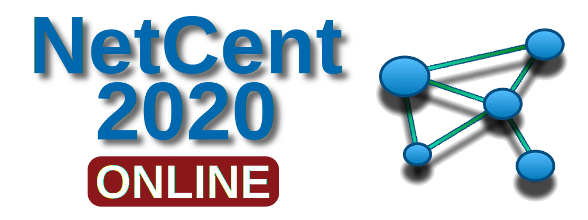Welcome
The Centrality in networks: structural and dynamical aspects (NetCent 2020) conference is a satellite of the NetSci 2020 conference, to be held September 17, 2020 in Rome, Italy.
This satellite will feature a mix of invited and contributed talks.
All attendees of the NetCent 2020 satellite must be registered for the NetSci2020 conference in order to attend.
Due to COVID-19 pandemic NetCent will be a fully online conference, as the main NetSci2020 conference.
NetCent 2020 Conference Description
The concept of centrality plays a fundamental role in the study of networked systems in a large variety of fields, ranging from biology and technology, to transportation and social networks. From a structural point of view, the centrality of a node describes how important the node is in the network. This importance can be related to how easily other nodes can be reached from it, or to how dense is its close neighborhood. Various approaches to structural centrality have led to different definitions, such as degree centrality, closeness, betweenness centrality, eigenvector centrality, Page-Rank centrality, etc. On the other hand, from a dynamical point of view, centrality measures play a role in the determination of the most influential nodes with respect to their capacity to affect dynamic activity in the network. In this respect various measures have been proposed, related to optimal impact in epidemic spreading, synchronization or diffusion, ranging from non-backtracking centrality to general dynamical influence.
While the issue of centrality has been a classic theme in traditional social sciences and therefore since the inception of Network Science, new observations have recently spurred interest in this area. Particularly interesting have been the introduction of centrality measures in temporal and multiplex networks, the increasing attention on the issue of centrality localization and its effects on dynamical processes, or the relation between different measures in both synthetic generative models and real-world topologies.
The objective of NetCent 2020 is to gather leaders and active newcomers in the field of centrality on networks to present a comparative picture of traditional methods and the most recent advances, from the two-fold perspective of centrality as a structure determinant and a dynamic indicator, emphasizing in particular the present open challenges in this area.
Invited Speakers
Hernan Makse (City University of New York, USA)
Kieran Sharkey (University of Liverpool, UK)
Organizers
Claudio Castellano, ISC-CNR, Rome
Romualdo Pastor-Satorras, UPC, Barcelona
Important Dates
August 2, 2020
Abstract submission deadline
August 5, 2020
Acceptance notifications (latest)
August 10, 2020
NetSci early bird registration deadline
September 17, 2020
NetCent 2020 conference
Abstract submission is closed.
Hernan Makse (City University of New York, USA)
Kieran Sharkey (University of Liverpool, UK)
For any inquiry please contact the organizers by sending an email to netcent2020@gmail.com
Organizers
Claudio Castellano, ISC-CNR, Rome
Romualdo Pastor-Satorras, UPC, Barcelona
| 13.40-14.30 | Kieran Sharkey (University of Liverpool, UK)
Localization of eigenvector centrality and an alternative perspective |
| 14.30-14.55 | Giulia Bertagnolli (Università di Trento, Italy)
Network depth: identifying median and contours in complex networks |
| 14.55-15.20 | Leo Torres (Northeastern University, Boston, US)
Non-backtracking Eigenvalues: X-Centrality and Node Immunization |
| 15.20-15.40 | Coffee Break |
| 15.40-16.30 | Hernan Makse (The City College of New York, US)
Superspreading k-cores at the center of COVID-19 pandemic persistence (how contact |
| 16.30-16.55 | Marco Buongiorno Nardelli (University of North Texas, Denton, US)
Tonal harmony, the topology of dynamical score networks and the Chinese postman problem |
| 16.55-17.20 | Tijana Milenkovic (University of Notre Dame, US) |
| 17.20-17.45 | Dane Taylor (State University of New York, Buffalo, US)
Eigenvector-Based Centralities for Multiplex and Temporal Networks |
